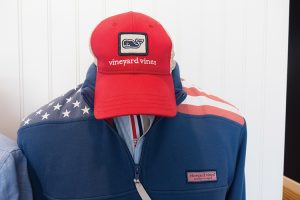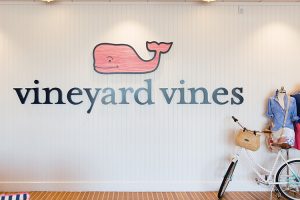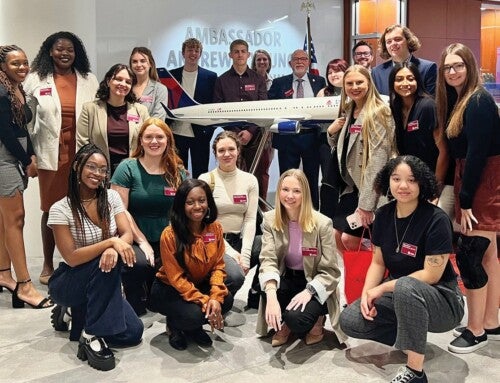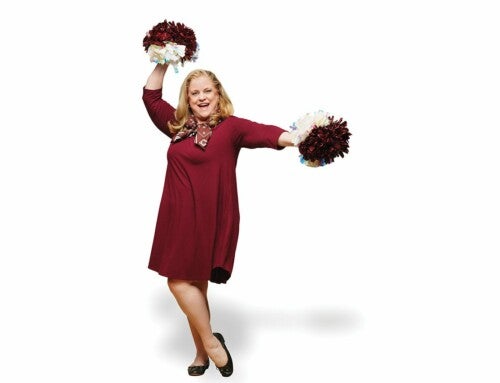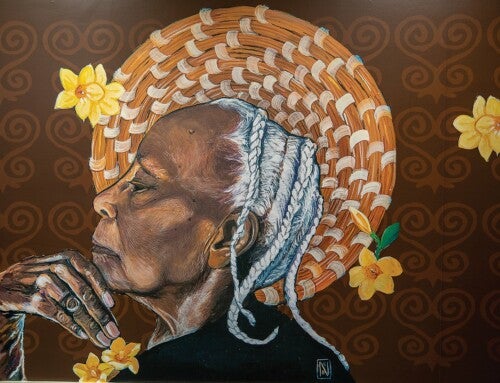The trademark pink whale of vineyard vines has become the symbol of the lifestyle brand’s seemingly overnight success. But behind the preppy clothier’s meteoric rise lies the unsung tale of Mike Gaumer ’98, whose liberal arts education and sports-infused leadership style have proven the real tie that binds it all together.
Mike Gaumer ’98, president of vineyard vines, doesn’t do many media interviews. At first, this might sound a little surprising for the head of a major lifestyle and apparel brand, a company with legions of loyal customers.
But there are a lot of things about Gaumer that don’t fit the stereotype of a corporate chieftain. He didn’t study business as an undergrad and doesn’t have an M.B.A. He didn’t rise through the ranks of industry or inherit a family business. In today’s social media–driven age of sharing and celebrity CEOs, he doesn’t tweet, his LinkedIn profile has no photo and his corporate bio is a succinct 80 words long.
Gaumer is a guy’s guy, a throwback to a time when successful people didn’t crave attention or praise. He’s of a breed that just put their heads down and work hard, regardless of whether anyone is watching. A self-effacing, wide-smiling, middle-aged family man, he loves to fish, drives a Ford F150 truck and wears shorts and flip-flops to the office.
And, despite the advice of some management gurus who would argue that sports analogies and metaphors oversimplify the complexities of business, Gaumer unabashedly speaks in the language of football.
It’s no wonder, then, that the employees at the company’s headquarters in Stamford, Conn., admiringly call him coach.
Xs and Os
To grasp Gaumer’s leadership style, it helps to know something about team sports, or, better yet, to know something about playing on a winning football team: the camaraderie, the selfless sacrifices, the day-in day-out grind of practice, pain and perseverance.
To understand a guy like Gaumer, you have to recognize that the best teams and the best organizations are good for a reason, and that winning is a process, a tradition and a mindset.
In 1992, Gaumer’s high school football team won the Pennsylvania state championship. As a senior, he played offensive guard and defensive end – a somewhat rare dual role that reflected his abilities on both sides of the ball. Nearly a quarter of a century later, folks in his hometown of Boiling Springs still talk about that Cumberland Valley Eagles team and their perfect 15-0 season.
The championship game was postponed for a week after a blizzard blanketed the town of Altoona and its stadium in several feet of snow. But the Eagles were not to be denied their flawless record. On game day, Dec. 20, 1992, after beating the Panthers of Upper St. Claire 28-12, Gaumer and his teammates climbed atop a six-foot snow bank that encircled the field and began harmonizing in unison to the words of their theme song – the Righteous Brothers’ “You’ve Lost That Loving Feeling.”
Led by a police escort on the bus ride back to their school gymnasium, the players were humbled to discover their exit off the Pennsylvania Turnpike clogged with vehicles. It seemed like every citizen in town had turned out to welcome the champions home at 1 in the morning.
To cap that magical season, Gaumer was named a two-way first-team performer in all-star voting. It had been one hell of a ride, a moment of glory he’ll remember forever, a story he’ll someday share with his grandchildren.
But even 24 years on, you can never fully extinguish the fire of a champion and his desire to be the best. Long after their prime, many athletes channel that competitive drive into new pursuits, seeking excellence in politics, entertainment or, as is the case with Gaumer, in business.
What you end up with is a company president who carries a football up and down the hallways of vineyard vines’ gleaming new headquarters building, spinning the pigskin on his fingertips and tossing it from one hand to the other.
What you end up with is a boss with a blue-and-gold sign over his office door that says, “Play Like a Champion Today.” A sign just like it hangs outside the Notre Dame football team’s locker room, where players ritualistically slap it as they take the field on game days.
What you end up with is a leader who idolizes legendary Green Bay Packers coach Vince Lombardi, who famously compared coaching a winning football team to running a successful business. “The principles are the same,” Lombardi said in his oft-quoted speech The Habit of Winning. “The object is to win – to beat the other guy.”
When the president of your company thinks and talks like a football coach, you end up with inspired employees who work together as a team, who share common goals and who strive every day to be better than the day before.
“Mike is definitely like a coach,” says Jeremy Buccolo ’07, who serves as assistant to one of the founders. “He compliments you when things are going well, and he lets you know when things aren’t going well. He’s very honest.”
Once you understand how Gaumer looks at the world, his behind-the-scenes persona begins to make more sense. He
shuns the spotlight, because, to him, teams – not individuals – accomplish greatness.
“I actually find it difficult to talk about myself,” he says. “Going back to team, I don’t feel like I’ve done any of this – we’ve done this together.”
By this, of course, he means building a company that has exceeded all expectations, except perhaps his own. Over the past 18 years, vineyard vines has grown from a three-person operation run out of a beach house into a 2,500+-employee clothing juggernaut with a harborside headquarters, products in some 500 department and specialty stores, and more than 70 of its own retail outlets around the country, from Newport Beach, Calif., to Charleston, S.C.
Brand of Brothers
 There’s another good reason that Gaumer prefers to avoid being the center of attention and to focus instead on the operations side of a booming business that has gained a foothold in the vaunted space of lifestyle brand stalwarts like L.L. Bean and J. Crew. And that reason has everything to do with the vineyard vines backstory.
There’s another good reason that Gaumer prefers to avoid being the center of attention and to focus instead on the operations side of a booming business that has gained a foothold in the vaunted space of lifestyle brand stalwarts like L.L. Bean and J. Crew. And that reason has everything to do with the vineyard vines backstory.
The true tale of brothers Shep and Ian Murray, who share the title of CEO and co-founders of vineyard vines, is too good not to love. In 1998, fed up with corporate culture and train commutes, the Greenwich, Conn., natives ditched their Manhattan jobs to make a go of it selling their own line of colorful silk neckties inspired by the laidback lifestyle and water-tinged sights and symbols of Martha’s Vineyard. Even the lower casing of the name “vineyard vines” reinforces the casual nature of the brand.
Their story is entrepreneurial, rebellious and rooted in a sincere passion for place. So it’s not at all surprising that the company smartly sticks to a script – the brothers inseparable from the brand. Look up any news article or video clip about the company and you’ll find these two handsome New Englanders smiling back at you.
But the Murrays will be the first to tell you that there’s more to the story behind the company’s success than what’s often portrayed in the press. There’s a key element missing in much of the coverage: It turns out that the dynamic duo is actually a triumvirate. He’s been called many names – the honorary third brother, the third leg of the management stool, the mediator, the tiebreaker. To the Murrays, Mike Gaumer is simply indispensable.
“Mike has been integral to the growth and overall success of vineyard vines,” says Shep Murray. “Ian and I like to say that Mike does the stuff we don’t want, like or know how to do, and in that way he’s become invaluable to the organization.”
For his part, Gaumer is content to watch the brothers adeptly function as the faces of the company while he looks on proudly from the sidelines, happily mired in the machinery and minutia of making clothes and managing a workforce: “I like being behind the scenes. It’s where I’m most comfortable. I think that’s why the dynamic works.”
Rust Belt to Sun Belt
Gaumer’s hometown of Boiling Springs is best known for its natural springs and its status as the original midpoint of the Appalachian Trail.
His parents still live in the same house where he grew up enjoying a typical childhood dominated by outdoor play and sports. Though he also played baseball, Gaumer’s passion was on the gridiron. With his strong performance on the squad that won the high school state championship, he had proven himself good enough to play college ball.
As Gaumer tells it, there wasn’t much debate about where he would play. His father had played football at Lafayette College in Easton, Penn., and so that’s what his son Mike would do, too.
Ian Murray was one of the first people he met after moving into his campus residence hall.
 “I met Mike during my first week at Lafayette; we lived on the same floor,” recalls Ian, also Gaumer’s fraternity brother. “He was always a likeable guy, easy to get along with and a lot of fun. Not to mention an accomplished athlete as a freshman on the football team.”
“I met Mike during my first week at Lafayette; we lived on the same floor,” recalls Ian, also Gaumer’s fraternity brother. “He was always a likeable guy, easy to get along with and a lot of fun. Not to mention an accomplished athlete as a freshman on the football team.”
Gaumer enjoyed the freedom of university life and being immersed in football and fraternity circles, but he also felt isolated by his surroundings. “When I went to school, there was still a Rust Belt,” he recalls. “We were up on this hill overlooking the steel town. It was not the most inspiring place to go to school. So you stayed on campus.”
After two years at Lafayette and having played football for much of his life up to that point, Gaumer began making plans to transfer to a new school. He was guided in his search by two criteria: a college without a football team and a campus located in a vibrant city. Having spent summer vacations with his family on the beaches of Isle of Palms, S.C., Gaumer was already familiar with Charleston. And the College of Charleston fit his requirements to a T.
Life without the familiarity of football and fraternity friends was an adjustment, but he eventually settled into Charleston that first year in 1996, lulled by the city’s rich history, natural environment and thriving nightlife. He took full advantage of all three.
A history major, he was captivated by the architecture and the national significance of the centuries-old buildings. From his apartment on Cumberland Street, he could look out over the church cemeteries and the rows of headstones bearing the names of famous colonial leaders. The Powder Magazine, which served as a gunpowder store during the Revolutionary War, stood right outside his front door.
“I loved the opportunity to go to school in a place where you could actually walk out the door and experience some of the things you were learning about in school,” says Gaumer. “To me, history is always something that is applicable to today … understanding what happened, why did it happen and how could you take steps to change that going forward. I use it every day in our business.”
He’s always found inspiration in stories about ordinary people in history who became famous after having enormous responsibility thrust upon them. Men like the late Army Maj. Dick Winters, a fellow Pennsylvanian whose heroic leadership during some of the bloodiest fighting of World War II was celebrated in the book and HBO miniseries Band of Brothers.
When he wasn’t immersed in history, Gaumer spent his time playing golf and going to the beach. At night, he hung out with friends at the Blind Tiger and The Griffon. He was giddy with excitement when John Kresse’s Cougars basketball team beat Maryland to advance to the second round of the 1997 NCAA tournament. Now that was a team with a winning tradition, he says.
Ian Murray would occasionally visit Gaumer in Charleston, and Gaumer also became friends with Ian’s older brother, Shep, with whom he shared a love of fishing.
As the end of his time at the College neared, Gaumer faced a decision about his future. He had a job opportunity with a company that made hospital beds, and although he wasn’t passionate about working in the healthcare industry, he had promised his parents he’d stick with his first job for at least one year.
“That was one of those character-building things,” he says. “I thought, ‘All right, I’m going to grit this out.’”
His role was to serve as a conduit between technicians in the field and programmers on the manufacturing side. The two groups didn’t get along well and communicated in very different styles. But being able to find common ground between different parties and broker compromises proved to be an invaluable skill that Gaumer would later rely on at vineyard vines.
“I work in a business with two brothers who are the founders,” Gaumer observes, “so you can imagine they are both passionate about different things, and, somehow, we have to find middle ground to move the company forward.”
He also learned in that first job that if you don’t have passion for your work, no amount of money, responsibility or perks will be enough to sustain you over the long haul. As he neared the end of his one-year job commitment, Gaumer considered trying law school until he could figure out what he was truly passionate about.
And then his phone rang.
Whale Tale
After simultaneously quitting their corporate jobs on Madison Avenue in 1998, Shep and Ian Murray started hawking a limited line of whimsical, nautical-themed neckties out of their Jeeps and backpacks, racking up $8,000 in credit card debt in the process.
Running their tiny company out of the Murray family vacation home on Martha’s Vineyard, the brothers were working day and night to get the company off the ground. As if they didn’t already have enough on their plates, Shep was about to get married. Realizing he couldn’t handle the workload by himself with Shep temporarily out of pocket, Ian knew just who to call.
Gaumer still remembers the pitch from the other end of the line: “They said, ‘hey, we are doing this thing with ties. Shep is going on his honeymoon, so we could use some help for a couple of weeks while he’s gone.’”
With no job and nothing better to do for a couple of weeks, Gaumer tossed a few bags into the back of his black Jeep Wrangler and headed north.
In those early days, it was all hands on deck. The first part of the day was spent answering phones, emails and faxes, and strategizing about new tie designs and product ideas.
“Then we’d basically drop what we were doing about 3 o’clock every day and go over to their parents’ house, where in Shep’s old bedroom was where all the ties were stored,” Gaumer recalls. “We’d go there, pick up all the ties, drive back to the office we had and ship them out.”
By the time Gaumer returned to Charleston a few weeks later to vacate his apartment and retrieve the rest of his belongings, he’d decided to give this tie thing a go. He also had work to do in Charleston, a sales call at Grady Ervin & Co. on King Street. He remembers being extremely nervous and thinks the store bought some ties out of sympathy for his lackluster pitch.
But he could see the potential of vineyard vines, and he believed that his liberal arts education would serve him well as he learned the business. And so, without a job title or any real experience, Gaumer became the first employee at vineyard vines.
As the company began to grow, the Murrays, who share a keen eye for colors and design aesthetics and a knack for marketing, were increasingly spending more time on business development. By default, it became Gaumer’s job to make sure the bills got paid and the lights stayed on.
They eventually sold that first run of 800 ties, and sales grew steadily as the new century dawned. Thanks to some important early business partnerships with select New England retailers, not to mention a lot of hustle and word-of-mouth advertising, the company had tapped into an authentic ethos that says work and play are not mutually exclusive.
Following their initial success with ties and other clothing accessories, it was time for the trio to design their first polo shirt in 2004. Having grown up with Lacoste, they knew they needed to make a statement with a simple yet distinctive logo that conveyed the Martha’s Vineyard vibe. They found inspiration in a wooden whale that the Murrays’ father hand-carved and hung on the outside of the family home.
Gaumer remembers there being a ridiculous number of conversations with the Murrays about the ideal trajectory for the whale’s smile. “We went through a lot of different iterations,” he says. “The smile is an important aspect of it because our motto – ‘Every day should feel this good’ – is important to us. So it had to be happy, but not too happy.”
No one could have imagined back then that the pink whale logo they designed would eventually be emblazoned, stitched, printed and painted on everything from bathing suits, button-downs and blazers to boxers, bags and belts … that every member of the family could be outfitted … that U.S. presidents, celebrities and sports figures would wear their products … that vineyard vines would be named the official style of the Kentucky Derby and the America’s Cup or that it would sponsor two professional golfers and a NASCAR driver.
No one predicted that the cute, grinning whale would become a generation-spanning status symbol for casual-minded, water-loving, fashion-conscious preppies who want to wear clothing that not only looks good, but feels good, whether you’re piloting a boat or steering a project at work.
Gaumer even allows that the whale might now be bigger than the name: “I would bet that if you ask a lot of people, they know what the whale is, maybe vineyard vines not so much, but everyone knows the whale.”
Work Hard, Play Hard
 Behind the scenes, Gaumer has his hands on virtually every facet of the company’s operations – from the fabric, fit and function of the clothes to vendors and suppliers in faraway places like Asia to the location and layout of the company’s U.S. retail locations, including the one that just opened on Kiawah Island, S.C.
Behind the scenes, Gaumer has his hands on virtually every facet of the company’s operations – from the fabric, fit and function of the clothes to vendors and suppliers in faraway places like Asia to the location and layout of the company’s U.S. retail locations, including the one that just opened on Kiawah Island, S.C.
He has 11 key employees reporting directly to him. In addition to senior executives, such as the chief financial officer and in-house counsel, Gaumer also oversees the division heads of major functions, including marketing, product, operations, retail, e-commerce and wholesale. Those last three are particularly important as they represent the company’s primary revenue streams, with retail accounting for about 40 to 50 percent, e-commerce about 25 to 30 percent and the balance from wholesale.
Between routine meetings, regular strategy sessions with the brothers, a busy national and international travel schedule and everything in between, Gaumer’s days are usually jam-packed.
A happily married father of three active children – ages 5, 7 and 9 – Gaumer is vigilant about making time for his family. He knows it will all go by in a flash if he allows work to swallow him up and doesn’t occasionally take time to appreciate his family and friends. That’s what the company preaches to its employees and its customers – work hard so you can play hard.
RELATED: Take a look inside vineyard vines’ posh, waterfront headquarters building in Connecticut.
Will Lanahan ’01, who pioneered the company’s foray into custom collegiate and athletics ties that now includes licensing partnerships with the NFL and MLB as well as dozens of universities, says there’s no doubt that Gaumer’s football background and Rust Belt upbringing forged his work ethic and managerial style.
“He is hardworking, driven and very demanding, but also fair and open-minded,” Lanahan says. “Simply put, Mike is the command center of vineyard vines – nothing happens unless it gets his blessing first.”
It wasn’t always this way. For several years he didn’t even have an official title, which was just fine with him. “To me, titles are always for outside, not inside,” he says. “For a great team, it doesn’t matter if you are left tackle, left guard – you are going to block the same people.”
But the company eventually grew big enough that Employee No. 1 needed an actual job title. So Gaumer became vice president of operations. Then, in 2008, he was named president.
Naively, Gaumer figured he was already doing the job of president, so the promotion was really just a change in title.
“Looking back, that was kind of foolish,” he says. “What I realized was I wasn’t really doing the job. Before, if the sales team wasn’t doing well, I still could say, ‘well, they are the ones.’ When I became president, no longer could I say that.”
In other words, it was all on the coach. And the game was about to turn ugly.
A Sinking Ship
Business was humming along until the economic recession hit. Suddenly it didn’t feel so good to be a high-end luxury brand when Americans were losing jobs and families were cutting back on discretionary spending.
At the time, aside from catalog and online sales and a few boutique stores, the company was primarily selling its products to wholesalers. When those stores stopped or reduced their orders, vineyard vines felt the contraction like a tightly cinched necktie.
“It was very scary,” Gaumer recalls. “Literally, I would get from our CFO a list of how much money came in, and I would sign checks for that exact amount of money to go back out. It was like living hand-to-mouth every single day.”
 Gaumer says this was a terrifying but valuable period because it forced the company out of its comfort zone and to reexamine its priorities.
Gaumer says this was a terrifying but valuable period because it forced the company out of its comfort zone and to reexamine its priorities.
“We did not want to be in a position where we were at the whims of other businesses. So we decided that our future was going to be in retail – that we wanted to control our message, to control our communication with the customer.”
The only problem was, Gaumer knew almost nothing about retail – how to scout for store locations, negotiate real-estate deals, seek zoning approvals, furnish a building or staff a store. But he knew he could learn.
At a time when most retail companies were scaling back plans for new stores, vineyard vines went all in and today is on pace to have 100 retail stores by the end of this year, with the potential for as many as 250 stores in the future. The Hail Mary pass saved the company.
“It ties back to that liberal arts education,” he says. “To me, the real value is that it teaches you how to think. It’s not about how to do this – it’s about how to think about doing these things and how to adapt when things don’t go the way you think they are going to. We have a saying around here that experience is what you get when you don’t get what you want.”
It’s no accident that the founders and president and dozens of others throughout vineyard vines are liberal arts graduates. Sure, a big company like this has M.B.A.s and lawyers and other professionals, and Gaumer says they are all indispensable.
But he can’t help but be a little biased toward an education like his own, one that exposes students to a wide array of subjects and provides a foundation for lifelong learning: “People that can think on their feet, can think about what’s happening, can react and adapt to situations, that is the real value of a liberal arts education. You’ve really got a broad perspective on things.”
Smooth Sailing
The lines of vineyard vines apparel and accessories have become so numerous that it seems there’s no place the whale can’t go.
And while Gaumer speaks openly about the future possibilities – expanding into new categories, for example – he’s also quick to say that every proposed and new product line must fit the story vineyard vines is telling and the lifestyle it’s selling.
There’s also talk of expanding the business into international markets, he says. “There’s a huge sailing community in a lot of parts of the world. Golf is huge everywhere. So there’s a lot of opportunity for us to expand the brand presence. We are just getting started.”
You’d think that Gaumer might be willing to concede that his team has reached a certain level of achievement, something akin to that perfect football season he was a part of so many years ago.
But this coach is relentless in his pursuit for greater feats: “I don’t think that we’ve achieved that much yet. There’s still so much opportunity out there for us. We’ve come a long way, and we’re proud and we celebrate where we are, but we have bigger aspirations and dreams for what we want to do.”
Yeah, Gaumer says, he’s happy. But not too happy.


